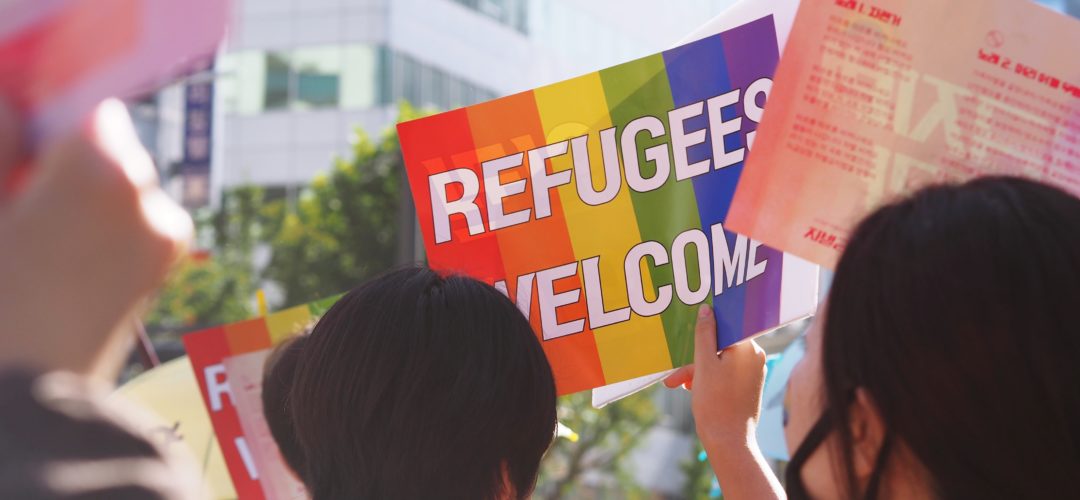How Welcome.US Is Empowering Americans to Support Refugees
March 03, 2022
 Tens of thousands of Afghan evacuees arrived in the United States following the Taliban’s takeover of Afghanistan in August 2021. As this unfolded, Welcome.US was launched to empower Americans to donate to frontline organizations, host arriving families, and find other ways to help Afghans as they rebuild their lives in a new country. The initiative, which is a sponsored project of Rockefeller Philanthropy Advisors, has mobilized a cross-sector, diverse coalition to assist Afghans and support newcomers now and in the future.
Tens of thousands of Afghan evacuees arrived in the United States following the Taliban’s takeover of Afghanistan in August 2021. As this unfolded, Welcome.US was launched to empower Americans to donate to frontline organizations, host arriving families, and find other ways to help Afghans as they rebuild their lives in a new country. The initiative, which is a sponsored project of Rockefeller Philanthropy Advisors, has mobilized a cross-sector, diverse coalition to assist Afghans and support newcomers now and in the future.
Nazanin Ash is CEO of Welcome.US. She previously served as vice president of Global Policy and Advocacy at the International Rescue Committee; has held senior positions at the U.S. Department of State and U.S. Agency for International Development; and served as a member of the Policy Planning staff for Secretary of State Hillary Clinton, Secretary of State Condoleezza Rice, and on the first leadership team for the President’s Emergency Plan for AIDS Relief (PEPFAR).
Ash spoke with RPA to explain the origins of Welcome.US, the unique partnership model of the initiative, and how efforts to welcome Afghan neighbors have evolved.
Please tell us about your journey. What drove you toward working on humanitarian issues and refugee resettlement?
I was born in Kansas to parents who had both emigrated from Iran as students with the expectation of returning to their families after completing their studies. But the 1979 Islamic Revolution in Iran happened during the last year of my father’s Ph.D. program, and my parents made the difficult decision not to return home, largely because of concerns for me. It set them on a totally different life trajectory than what they anticipated when they began their life together. They were separated from their families for years, built a new life in the United States, and worked hard to secure opportunities for me and my brother.
My parent’s unexpected immigrant experience and the opportunities they created for me fueled an ambition to help ensure that nothing about the circumstances into which people are born curtails their ability to meet their human potential—whether race, religion, gender, or geography. Initially, I was involved in domestic poverty policy and child protection. That grew into a broader ambition globally around human rights and access to equitable political and economic opportunity. Ultimately, that brought me to advocacy on rights and access to safety for displaced populations—millions of displaced people, due to circumstances beyond their control, are living their lives in limbo and curtailed from being able to achieve their human potential.

Nazanin Ash
How was Welcome.US conceived?
Welcome.US was founded to address the extraordinary national challenge of resettling close to 100,000 Afghans in less than 6 months. This challenge came on the heels of more than five years of a thorough decimation of the refugee resettlement system. To put it in context, the U.S. refugee resettlement system had resettled just over 11,000 refugees in the previous year, and now they were called upon to do almost 10 times that number in half the time.
But the insight of Welcome.US’ cofounders, John Bridgeland and Cecilia Muñoz, is that it’s a challenge we can meet if we tap into the broad capacity and willingness of American people and institutions to welcome and support our newest Afghan neighbors. After the fall of the Afghan government, there was an incredible moment of unity around welcoming Afghan allies and those fleeing violence in Afghanistan. We have an opportunity to bring diverse contributors together across sectors, and across real or perceived divisions, to unite and provide support for Afghan newcomers—and in so doing build a durable, cross-divide commitment to welcoming newcomers of all backgrounds.
That theory of change—building cross-divide commitment to welcome by bringing more people into the work of welcoming—is already proving possible. Veteran’s groups, Afghan- and Muslim-led groups, the private sector, iconic service organizations like Lions Clubs International, and diverse relief organizations from Samaritan’s Purse to Islamic Relief USA are all stepping up to assist the response. Our hope is that once a welcomer, always a welcomer.
Global displacement is an extraordinary challenge—there are nearly 30 million refugees globally, and on average less than 3 percent are able to return home—and fewer than 1 percent have the opportunity to be resettled. This challenge will only be exacerbated as a function of climate change. We need solutions that allow displaced populations to have pathways to safety, citizenship, and the tools to rebuild their lives in countries providing refuge and opportunity. But as societies, we lack the space to make the right kinds of policy decisions to effectively and productively welcome and include newcomers. We need to build that capacity and willpower. That is at the heart of Welcome.US’s mission.
What factors allowed Welcome.US to launch in such a short amount of time?
Welcome.US’ unique partnership model was a key factor that allowed us to get started as quickly as we did. We are a cause platform more than a new competitive operational player. We’re mobilizing the desire of Americans to help, we’re making it easier for them to help by connecting them to partners on the frontlines and forging new pathways for them to assist, and then we’re targeting that capacity and those resources to serve Afghan arrivals and support the communities where resettlement is happening.
For example, we’ve had more than 900 large and small donors contribute more than $16 million to the Welcome Fund to date. We approved our first round of grants within four weeks of launching. That represented a new model of urgent and innovative grant-making that sought to be directly responsive to the needs of frontline responders and the housing challenges faced by newly arrived Afghans.
Similarly, as a cause platform, we lift up the work of our partners. We’ve developed the Welcome Directory where people can find local organizations in their communities that are supporting this work. We built the Welcome Exchange to facilitate in-kind donations so that the needs of frontline organizations can be matched with donations from businesses looking to help. We built an Employment Exchange that has posted more than 46,000 jobs from employers who are eager to hire Afghans, and we launched a partnership with Team Rubicon, a veteran-led crisis response organization, to mobilize veteran and other community volunteers in cities across the country.
The work is focused on bringing resources and partners together, making it easier to find ways to contribute, and making it easier for frontline organizations and newcomers to benefit from the enormous outpouring of support.
It’s been several months since Welcome.US was launched. How have the needs evolved for Afghan newcomers and how is Welcome.US adapting?
The work of welcoming is just beginning. It’s only been in the last couple of months that Afghan newcomers have moved in large numbers out of temporary safe havens and into the communities where they’re going to rebuild their lives.
With our partners, we’ve been supporting the journey of Afghan newcomers from in-kind goods delivered to safe havens, to providing free flights to their new communities with donated airline miles, to free temporary housing provided through airbnb.org and the thousands of people who opened their homes. Now it’s time for the deep work of supporting families to rebuild their lives—moving them into permanent housing, supporting kids who are entering new schools in a very different context for the first time, supporting parents to find employment that meets their skills and enables them to provide for their families. All that work is happening right now, and this is where the capacity and compassion of the American people can be brought to bear.
The war in Ukraine has triggered yet another refugee crisis. How can funders best support and engage with relief efforts?
What’s so critical right now is to support partners who are rapidly scaling up operations to respond. Consistent with our mission, what we’ve done at the outset is to lift up those partners. Organizations are responding in countries like Poland, receiving the bulk of Ukrainians seeking safety, and of course within Ukraine to provide for basic needs and medical assistance. Another priority is lifting up the willingness of people to welcome. It’s incredibly moving to see Polish and Romanian families, for example, lining up in their cars at the border ready to pick up Ukrainian families and provide them with safety and shelter. There’s been an incredible outpouring of support from the public, and it’s been inspiring to see European governments mobilize to provide assistance.
For people and organizations who are looking to launch efforts quickly, I would point to the value of serving as a center of gravity for all who want to help—providing a place where people can find the information they need for how to help and quickly get connected to where it’s needed most. Those platforms are in short supply and those partnership models can be highly effective.
As far as Welcome.US, as we said in our statement last week, we know from our experience with Afghan newcomers that Americans have deep capacity and compassion, and we stand ready to mobilize in support of Ukrainians seeking refuge in the United States.
Photo by Ra Dragon on Unsplash
Back to News